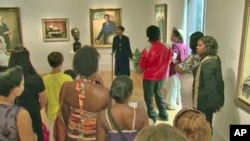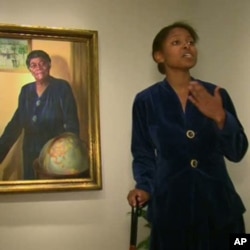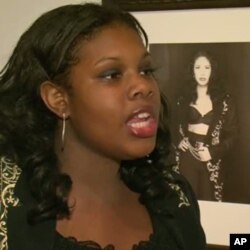Teenagers are making portraits come alive this summer at the National Portrait Gallery in Washington, D.C., this summer.
They put on makeup and make final alterations to their costumes. It’s like being backstage in a theater, but in this case the stage is the museum itself.
Dressed in a blue velvet suit and carrying a cane, just like the woman in the portrait behind her, Taylor Marsh looks like a younger version of educator and civil rights leader Mary McLeod Bethune.
She's one of 10 students participating in "Portraits Alive!" at the National Portrait Gallery. Like most of the students, she came to the program because she's interested in theater.
“I had no idea what this program was going to be about,” says Marsh. She was told they would be doing tours of the museum, but the tours they give rely on acting skills.
“I look for students who are interested in the performing arts,” says Geri Provost Lyons, who is in charge of the program.
“They choose a portrait, and they do research on the people that are in these portraits, and then they perform in costume a monologue which they have written.”
Students spend the first four weeks preparing, then perfecting and rehearsing their monologues in front of each other.
“Writing the monologue was the hardest part,” Marsh says. She was one of the few students who didn’t pick an entertainer or movie star.
Bethune was born in 1875, just a decade after the end of slavery. She founded a school for African American girls in 1904 and organized the National Council of Negro Women in 1932. In 1936, she became an adviser to President Franklin Delano Roosevelt.
“It wasn’t really the occupation I thought of, it was more the person in general,” says Marsh. “She was a strong woman, she had a lot of things going for her, and I wanted someone who was headstrong.”
Sydney Hall chose Hollywood star Katharine Hepburn, who died in 2003. “I didn’t know anything about Katharine Hepburn. I was just passing her portrait and I thought she looked very angelic in it, and she looked very cool.”
Hall says the program has had an impact on her. “I don’t spend a lot of time in museums. DC born and raised and I’ve been to all the museums, but now I’m actually taking the time to learn.”
Rashawn Alexander portrayed Latin music star Selena, who was murdered by a fan in 1995 at the age of 23. She was an icon for young people, and Alexander was impressed by how she gave back to the community, offering a free concert to students who improved their grades.
“I picked her because me and her have a lot in common," says Alexander. "We both want to see kids do well in our community.”
Alexander says she, too, now takes time to read about the art work in the galleries, instead of just glancing at it.
Geri Provost Lyons says that’s true of a lot of the students in the program. “They will take time to go to different museums and learn more and want to see more.”
And that, she says, is one of the goals. As for the students, it doesn't hurt that they get paid for the performances - $7.25 an hour.













